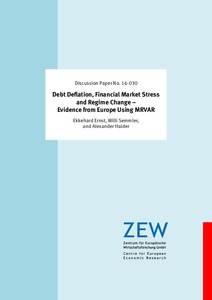Debt deflation, financial market stress and regime change – evidence from Europe using MRVAR
"The economic meltdown since 2008-9 has created disinflation, and even deflation in some countries in the Euro-area, in a period with large debt overhang, creating the condition for a continuing financial market stress in the Euro-area. As disinflation and deflation push up the real interest ra...
| Main Authors: | , , |
|---|---|
| Institution: | ETUI-European Trade Union Institute |
| Format: | TEXT |
| Language: | English |
| Published: |
Mannheim
2016
ZEW |
| Subjects: | |
| Online Access: | https://www.labourline.org/KENTIKA-19104792124919229749-Debt-deflation,-financial-mark.htm |
| Summary: | "The economic meltdown since 2008-9 has created disinflation, and even deflation in some countries in the Euro-area, in a period with large debt overhang, creating the condition for a continuing financial market stress in the Euro-area. As disinflation and deflation push up the real interest rate, while growth and income declines, the leveraging problem becomes more severe and the economy risks shifting into a regime with high insolvency risk, high financial stress, rising credit spreads, possibly accompanied by strong adverse macroeconomic feedback loops. Investigating the consequences of those magnifying feedback loops, given the debt deflation, we demonstrate the possibility of unstable dynamics and downward spirals in the presence of regime-dependent macro feedback loops, using a theoretical model with decentralized matching mechanisms on both labor and financial markets. To explore the amplifying linkages between deflation, output, labor and financial markets, we employ a new solution procedure called NMPC to solve our models variants for out-of-steady-state dynamics. We empirically explore deflationary trends in Europe and employ a Global VAR (GVAR) model for a large euro area macro data set to estimate the impact of deflation on output. Moreover, we use a four variable Multi-Regime VAR (MRVAR) model with regime dependent IRs to study deflationary as well as well as the financial risk drivers in a MRVAR setting. New measures for financial risk drivers are employed and multi-regime IRs for output, inflation rates, interest rates and financial stress are explored. We also study regime changes in central macro relationships such as regime change in the credit - output link, the Phillips curve and in Okun’s law." |
|---|---|
| Physical Description: | 38 p. Digital |

